
Treating Sprains and luxations Page Menu: 1 2 3 4 5 6 7 8 9 10 11 12 13 Next>>
Treating Sprains & Dislocations in the Golden Age of Piracy, Page 12
Dislocation/Luxation Complications
“Wounds of the Joints are subject to more grievous Accidents than those I have heretofore mentioned; therefore they require your more particular care; the Tendons and ligaments being inserted near the Joints for the motion thereof: there are also Membranes, which do consequently render them of a most exquisite sense. The Trunk of Nerves also in every great Joint passeth through, for the use of the Member that is beyond it.” (Richard Wiseman, Severall Chirurgical Treatises, 1686, p. 429)
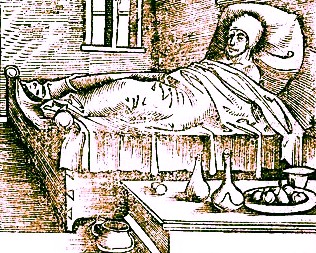
Ulrich von Hutton Sick in Bed (16th c.)
A variety of complications could occur during the long recovery times many dislocations required. While most of the surgeons writing during this period mention the types of complications that could occur, French surgeon Ambroise Paré does yeoman's work presenting and explaining the cure of several of them in the section on dislocations. He also presents a large list of them: "Many things may befall broken or dislocated members by the means of the fracture, or dislocation; such as are bruises, great pain, inflammation, a fever, impostume, gangrene, mortification, ulcer, fistula, and atrophia, all which require a skilfull and diligent Surgeon for their cure."1
Some of these have been dealt with in other articles on this website and their cure is best viewed in their particular article. These include bruises (unbroken skin wounds) and gangrene/mortification. In addition, ulcers are open sores and are discussed in detail in the article on simple wounds. Paré himself notes that fistulas (unnatural tunnels between two places in the body) occurred as a result of a corrupt bone, something not generally associated with the dislocation, although it could contribute to causing the dislocation. We will look here briefly at the complications of pain, swelling, inflammation and fevers. This will be followed by a more extensive discussion of stiff joints, atrophy of the muscles due to a dislocation and dislocations with fractures.
1 Ambroise Paré, The Workes of that Famous Chirurgion Ambrose Parey, 1649, p. 398 (mispaginated)
Dislocation/Luxation Complications - Pain, Swelling, Inflammation & Fevers
French surgeon Ambroise Paré directs that when "a great swelling, pain and inflammation urge, we must first think of asswaging and curing them, then of the restoring the Dislocation."1 He explains that pain occurs because the bones are out of place, allowing them them to "becom troublesom to the muscles and nervs by pricking and pressing them. Hence ensue inflammations, as also impostumation and a fever"2. In his treatment of a dislocated ankle, he notes that "pain, swelling, and other the like ensue, which implore remedies, & the Surgeons help, to wit, convenient diet, and drawing of blood by opening a vein (of which... it is here requisite by reason of the Feaver and inflammation) and if need require purgation, principally such as may divert the matter by causing vomit [using emetic medicines]"3.
Treating pain has already been discussed several times in regard to both sprains and dislocations in this article. Still, it is worth repeating some of the favored medicines employed, although they are probably quite familiar by now. Richard Wiseman suggests a variety of topical medicines including oil of roses, oil of
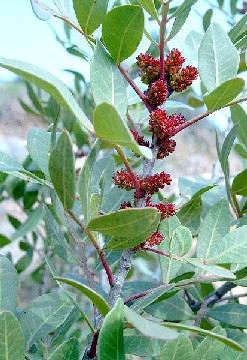
Mastic Tree Leaves and Fruit
earthworms, oil of mastic tree resin, emplaster é bolo [a plaster composed of oil, litharge or elemental lead, and bole or argillaceous earth], diapalma plaster and red lead plaster.3 Sea surgeon John Moyle uses Oil of St. John's wort, Paracelsus' Plaster or the Opodeldoch Plaister4 as well as his own medicine Cataplasma Resolvens.5 In addition to several of the medicines already mentioned, sea surgeon John Woodall advises the use of oil of dill and diacalsiteos plaster.6 Like many other surgeons, Paré suggests oil of roses but mixes it with egg white.7
Paré implies that fevers in dislocations result from the inflammation of the area around the dislocated bone. In his discussion of ankle dislocations he says "the corruption of this part first by contagion assail’s the next, and thence a Fever assail’s the heart by the arteries pressed and growing hot by the putrid heat"8. Paré himself does not give recommendations about how to treat fevers caused by a dislocation. However, suggestions do appear in the period surgeon's texts.
When talking about a dislocated hip, sea surgeon John Atkins notes that the patient should be placed in "the quietest and easiest Position. Venesection [letting blood], Clysters [enemas], and Dieting [to inhibit the creation of 'gross' or detrimental humors], are to contribute likewise their Share in preventing Fever and other Disturbances."9 English surgeon Richard Wiseman implies the use of restrictives will help prevent inflammation in his discussion of elbow dislocations.10 These are medicines which are designed to stop flows of humors, particularly blood, as well as to cleanse the area. John Moyle recommends "this maturative Cataplasm following, Rx. Unguent. Basilic[on]. Major. De Mustagia.11 Empl. Melilot. symp. q. s. misce. [mix as much as is sufficient] fiat Cataplasma [make into a cataplasm]."12 'Maturing' here refers to causing the wound to form pus and eject it which was considered a sign that the bad humors were being purged from the area and healing would progress with less fear of complications. There is much more to treating fevers during the golden age of piracy than this brief list, but it shows how they were prevented relative to dislocated joints.
1 Ambroise Paré, The Workes of that Famous Chirurgion Ambrose Parey, 1649, p. 382; 2 Paré, p. 398 (mispaginated); 3 Richard Wiseman, Of Wounds, Severall Chirurgicall Treatises, 1686, p. 481; 4 John Moyle, Abstractum Chirurgæ Marinæ, 1686, p. 62; 5 Moyle, Chirugius Marinus, 1693, p. 21; 6 John Woodall, the surgions mate, 1617, p. 169; 7 Paré, p. 384; 8 Paré, p. 397 (mispaginated); 9 John Atkins, The Navy Surgeon, 1742, p. 109; 10 Wiseman, p. 492; 11 'de Mustagia.' means "of Mustagia", which in this context usually refers to the person whose book contains the prescription.. With the spelling (and understanding) of names (particularly foreign names), being rather fluid during this time, it likely refers to an Arabic pharmacopoeia, possibly Masawaih al-Mardini's (Mesue the Younger's) Antidotarium sive Grabadin medicamentorum, which was popular with English physicians and surgeons; 12 Moyle, Chirugius Marinus, p. 62;
Dislocation/Luxation Complications - Stiff Joints
"Furthermore, there is sometimes hardness left in the joints, after fractures and dislocations are restored." (Ambroise Paré, The Workes of that Famous Chirurgion Ambrose Parey, 1649, p. 382)
Stiffness of the joints is a complication that was in certain cases felt to be untreatable.1 However, several surgeons offered suggestions on how a stiff joint might be treated, typically using medicines.
Sea surgeon John Moyle mentions stiffness in the joints as being one of several such problems helped by his list of medicines found here. English surgeon Richard Wiseman fomented
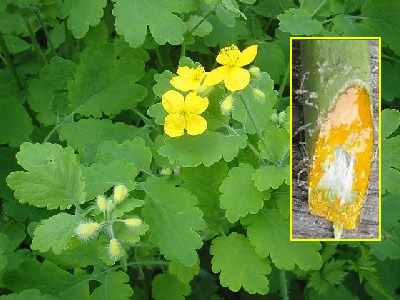
Panax Hereculeum (Chelidonium majus) Plant, Inset (Photo: Antti Bilund)
Showing
Resin for Opoponax Inside Cut Stem of Plant
the joint "with emollient Herbs boiled in Flesh-broth, and embrocated them daily with ol. lumbicor. [oil of earthworms] applying a Cerote [oily mixture] of unguent. dialthææ [ointment of marsh mallows] and Wax over all."2 Ambroise Paré said that stiffness in the joints could be softened
by resolving [reducing] the contained humor by fomentations, liniments, cataplasms, emplasters made of the roots of marsh-mallows, brionie, lillies, line [flax] seed, fenugreek seed, and the like, and also of gums dissolved in strong vineger, as ammoniacum, bdellum, opopanax, labdanum. sagapenum, styrax liquida, and adeps anserinus [goose fat], gallinaceus [chicken fat], humanus [human fat], oleum liliorum, and the like.3
Paré added that the joint must be moved daily so "that it bee not painful to him, that so the pent up humor may grow
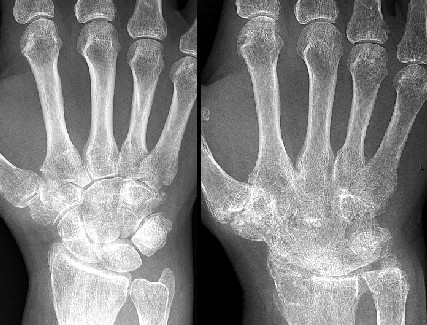
Photo: Mikael Häggström - Anklyosis in the Hand: Normal (left), Fused (right)
hot, bee attenuated, and at length discussed [dispersed], and lastly the part it self restored as far as art can perform it"4. John Atkins had a different take, stating that the surgeon "should endeavor to restore the Nerves and Tendons to a due Tensity again; and this, in my Opinion, can by nothing be more effectually done, than by the immediate Use of the Cold Bath, a Means that will restore them to their proper Springiness and Stiffness"5.
For ankle dislocations, Atkins also notes that some patients have trouble with anklyosis, which refers to fusion of the bones in a joint. Atkins says that this is a problem particularly for older patients and warns "when we lend a helping Hand, and fix it immoveably, as it were, by Bandage and Splints, we have Reason to fear an Anchilosis by it"6. He goes on to explain "The Synovia [synovial fluid] in the Joints, by so long a Stillness and Inaction, both here [in a fracture] and in the Luxation, (curved or strait) gluing the Heads of the Bones like a Callus. I have seen the Tibia and Femur, the Humerus, Ulna and Radius, from such a Cause, so cemented, as to appear like one continued Bone."7However, he has no suggestions for remedying this.
1 For example, see John Atkins, The Navy Surgeon, 1742, p. 110 & Ambroise Paré, The Workes of that Famous Chirurgion Ambrose Parey, 1649, p. 398 (mispaginated); 2 Richard Wiseman, Of Wounds, Severall Chirurgicall Treatises, 1686, p. 84; 3,4 Paré, p. 398 (mispaginated); 5 Atkins, p. 117; 6,7 Atkins, p. 44
Dislocation/Luxation Complications - Atrophy of the Muscles
"But an atrophia and leanness ariseth by the sloth and idleness of the member decaying all the strength thereof, and by too strait [tight] ligation intercepting the passages of the blood otherwise ready to fall and flow thither.” (Ambroise Paré, The Workes of that Famous Chirurgion Ambrose Parey, 1649, p. 398 (mispaginated))
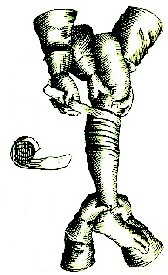
Tight Bandaging, From l'Arcenal
de Chirugery, By Johannes
Scultetus, p. 106 (1665)
Most of the discussion of atrophy of the muscles following a dislocation comes from Paré's book. He doesn't shirk his duty here, presenting a wide variety of suggestions for ways the problem can be remedied. Since the easiest solution was simply loosening the over-tight bandage, he opens with that.
He goes on to point out that some surgeons "wish also to bind up the decaying member with moderate ligation; for thus, say they, the blood is drawn thither; for when as wee intend to let blood by opening a vein with a lancet, we binde the arm."1 This sounds counter-intuitive. Paré rationalizes it by suggesting if it makes the part red and hot, this is a sign that the atrophy will heal; if not, "the case is desperate, wherefore you need attempt nothing further."2 In fact, the purpose of putting a tourniquet on a limb is not to bring nourishment (by which they mean blood) to the part, but to keep it from getting back to the heart, making the veins swell and thus easier to find when taking blood. So this wouldn't work quite like they thought.
In a related vein, Paré gives an even more extraordinary suggestion: bind the limb opposite the one that was dislocated with a ligature, 'yet without pain.' He explains if the dislocation is in the arm, the opposite arm should be bound from hand to armpit, if in the leg, from the bottom of the foot to the groin.
For thus a great portion of the blood is forced back into the vena cava, or hollow vein, and from this being distended and over full, into the part affected and gapeing with the vessels almost emptie; besides also it is convenient to keep the sound part in rest, that so it may draw the less nourishment, and by that means there will bee more store to refresh the weak part.3
This may sound a bit bizarre, but the idea of forcing fluids away and towards opposite places was not uncommon in humoral treatments. English surgeon Richard Wiseman refers to the process as translation, noting
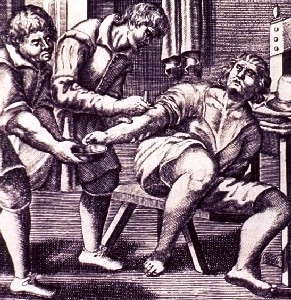
Bloodletting, From Nuova et Utlilssima Prattica di Tutto,
By Cintio d'Amato, p. 51 (1671)
that three types of it were used: revulsion, derivation and repulsion. Revulsion and derivation are similar to each other in that they draw unwanted humors away from the problematic part. Wiseman explains that they "differ only in the measure of the distance, and the force of the Medicines used. If we draw it to some very remote, or,
it may be, contrary part, we call that Revulsion: if only to some neighbouring place, and by gentle means, we call it Derivation."4 So letting blood in the arm to the wounded arm to draw the blood humors away would be revulsion while placing blister plasters on the back for problems in the head would be derivation. The third type of translation, repulsion, is used when the unwanted humor "is already impacted [and] will not so easily be drawn out by former remedies, if something be not applied to the Part to drive it back."5 So the purpose here is to use medicines to force the unwanted humors away from the part.
Paré also suggested immersing the atrophied part "into water somwhat more than warm, and hold it there until it grow red and swell; for thus blood is drawn into the veins"6. Paré also orders that "moderation shall be observed in the warmness of the water, and in the time of fomenting. For too long fomenting resolv’s [dissipates] the blood that is drawn. But that which is too little or short a space draw’s little or nothing at all"7. Paré similarly recommends 'frictions' in combination with the warm water, which involves rubbing the part vigorously. "The frictions must be moderate in hardness and gentleness, in length and shortness."8 The goal with all of these things appears to be to bring nourishment to the part in the form of blood.
Exercise has been mentioned by several of the authors as a way to help the patient recover from a dislocation. Richard Wiseman suggested it in his general cure of all dislocations.9 Sea surgeon John Atkins said that he had seen the muscles and tendons "unbended and straitened after about a quarter of an Hour’s such Exercise with the Limb"10 in his recommendation for fixing a dislocated ankle. He also recommends moving a dislocated elbow to prevent it from seizing up. Paré explains that an atrophy "which proceed’s from idlenesse is helped by moderate exercise, by extending, bending, lifting up and depressing the member, if so bee that hee can away with exercise."11 He elsewhere explains that "the performance of the proper action encreases strength, and makes the part in better plight"12.
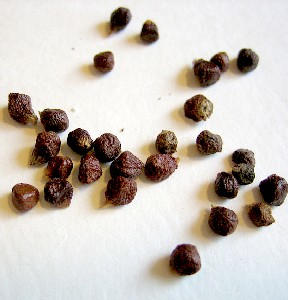
Grains of Paradise (Aframomum Melegueta)
Last among Paré's recommendations were medicines. He advises the use of "hot and emplastick [adhesive] medicines made of pitch, turpentine, euphorbium, pellitory of Spain [Anacyclus pyrethrum], sulphur, and the like"13 which are to be applied as needed. He provides a recipe for one of them:
Rx. picis nigræ [black or navy pitch], ammoniaci, bdelii[um], gummi elemi in aqua vitæ dissolutorum [gum elemi dissolved in concentrated ethanol] {of each 2 ounces} olei laurini [oil of bays] {1 ounce} pulveris piperis [powdered pepper], zinziberis [ginger], granorum paradisi [grains of paradise], baccarum lauri et juniperi [bay and juniper berries], {of each 2 ounces} fiat emplastrum secundum artem [make into a plaster according to art], extendatur super alutam [spread over soft leather].14
Only one other author mentions a treatment for atrophied muscles. Since this problem was identified as being humor-based, Richard Wiseman provides a humor-based solution. In one of his case studies involving a patient with a tumor Wiseman explained that that patient's "Arm was extremely emaciated. For the nourishing of it I made a Fontanel in that Arm"15. A fontanel is an incision into which an irritant is placed to keep it open and festering in order to generate pus and eject unwanted fluids from the body.
1,2,3 Ambroise Paré, The Workes of that Famous Chirurgion Ambrose Parey, 1649, p. 398 (mispaginated); 4,5 Richard Wiseman, Of Wounds, Severall Chirurgicall Treatises, 1686, p. 7; 6,7,8 Paré, p. 398 (mispaginated); 9 Wiseman,p. 481; 10 John Atkins, The Navy Surgeon, 1742, p. 112; 11 Paré, p. 398 (mispaginated); 12,13,14 Paré, p. 381; 15 Wiseman, p. 84

